Looking for the best products for your Rottweiler? Visit our Review Page where experienced veterinarians and Rottweiler experts share their top picks for food, toys, and health care accessories. Find trusted recommendations to keep your Rottweiler happy and healthy!
-
Eye-catching inheritance: Did you know that Rottskys can inherit the striking blue eyes of their Husky parent? And sometimes, they even have one blue eye and one brown eye – that's called heterochromia, and it's seriously cool!
-
Vocal variety show: Rottskys are known for their unique vocalizations. They might bark, howl, or even "woo-woo" like their Husky parent. It's like having your own canine choir!
-
Hidden talents: Rottskys are incredibly versatile dogs. They can excel in a variety of activities, from agility and obedience to therapy work and even sledding (they've got those Husky genes!). Who knows what hidden talents your Rottsky might have?
Meet the Rottsky - A Wild and Wonderful Mix!
Ever wished for a dog that could rock both a sledding adventure AND a guarding gig? Boom! You’ve got yourself a Rottsky – a captivating combo of Siberian Husky sass and Rottweiler loyalty. These pups are like the superheroes of the dog world, with energy levels that’ll put you to shame and a heart of gold that’ll melt yours.
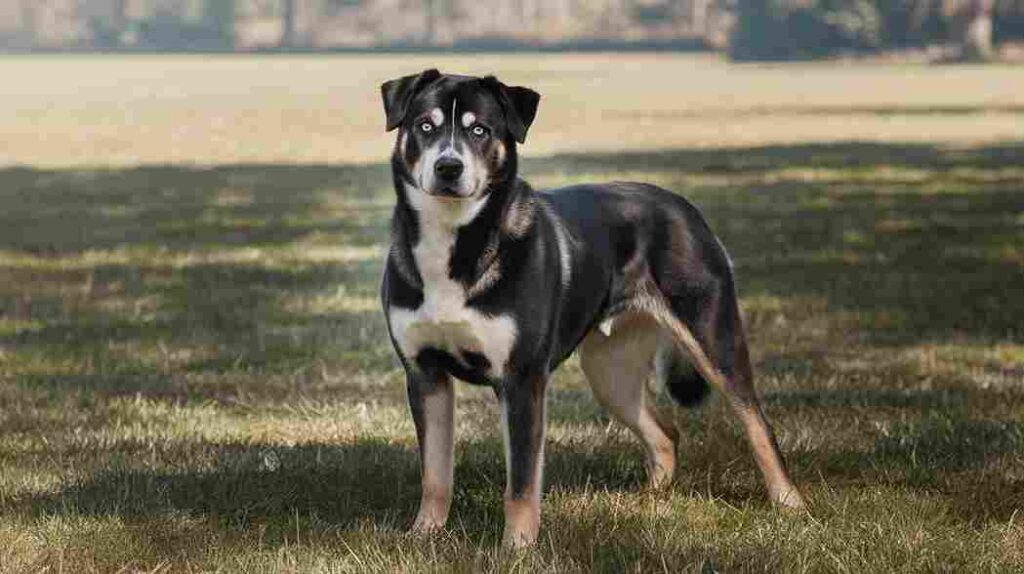
Why are Rottskys becoming so popular? Well, they’re not just a pretty face (though those Husky eyes are pretty mesmerizing, aren’t they?). They’re also incredibly loyal, playful, and intelligent. But beware, these pups are not for the faint of heart! They need an owner who can keep up with their wild side and provide them with the love and training they need to thrive.
Ready to unleash the awesomeness of the Rottsky? Let’s dive in!
Breed Characteristics: Where Rottweiler Met Husky
Want to know what happens when a loyal guardian meets a wild adventurer? Get ready for the Rottsky – a captivating mix that’s as unique as its parents!
Parent Breeds: A Tale of Two Wolves
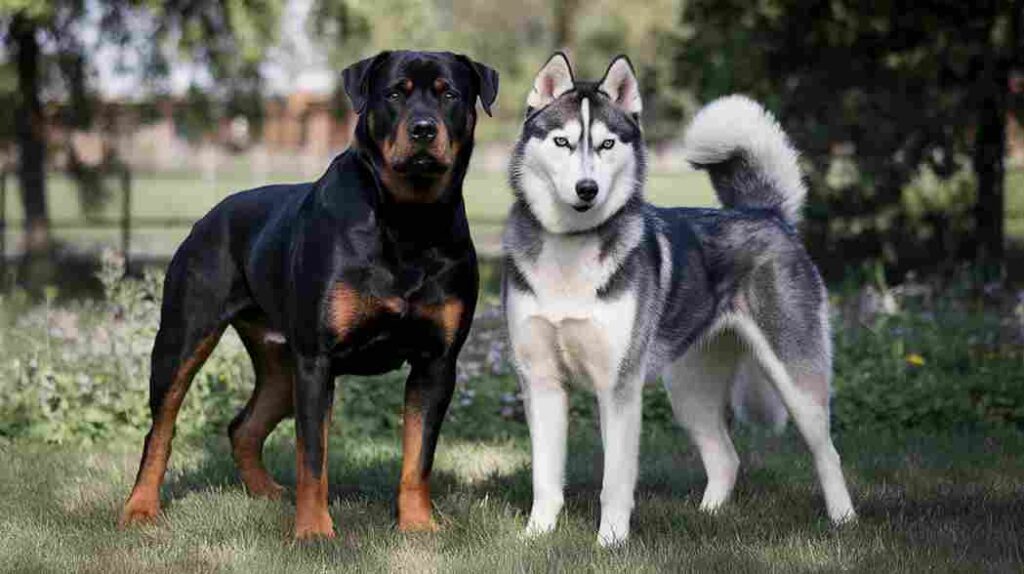
- Rottweiler: The loyal protector with a heart of gold. These gentle giants have a history as guardians and working dogs, always ready to defend their loved ones. They’re intelligent, affectionate, and sometimes a bit stubborn (but hey, that’s part of their charm!).
- Siberian Husky: The adventurous spirit with a love for the great outdoors. Huskies were born to run and explore, with a history of pulling sleds across snowy landscapes. They’re independent, energetic, and always up for a challenge. Think of them as the free spirits of the dog world.
- Appearance: A Striking Combination
Rottskys inherit a unique blend of traits from their parents, resulting in a stunning array of looks.
- Coat Colors and Patterns: You might see the classic black and tan of a Rottweiler, the striking markings of a Husky, or a mesmerizing combination of both. Think black and white, gray, sable, and even brindle!
- Those Eyes: Rottskys often have those captivating Husky eyes, which can be blue, brown, or even a mesmerizing mix of both (heterochromia).
- Size: They’re typically medium to large dogs, but their exact size can vary. Expect them to be anywhere from 20 to 27 inches tall and weigh between 55 and 95 pounds.
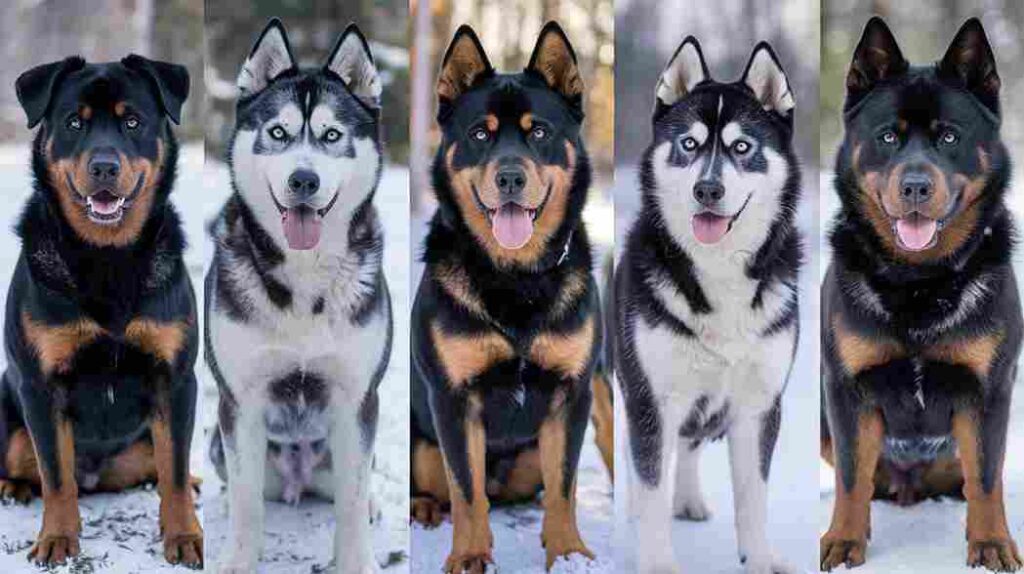
Temperament and Personality: Loyal, Playful, and a Little Bit Wild
Rottskys are the total package when it comes to personality! Here’s what you can expect:
- Loyal and Loving: These dogs are deeply devoted to their families, but they also have an independent streak. They’ll shower you with affection one minute and then be off on their own exploring the backyard the next.
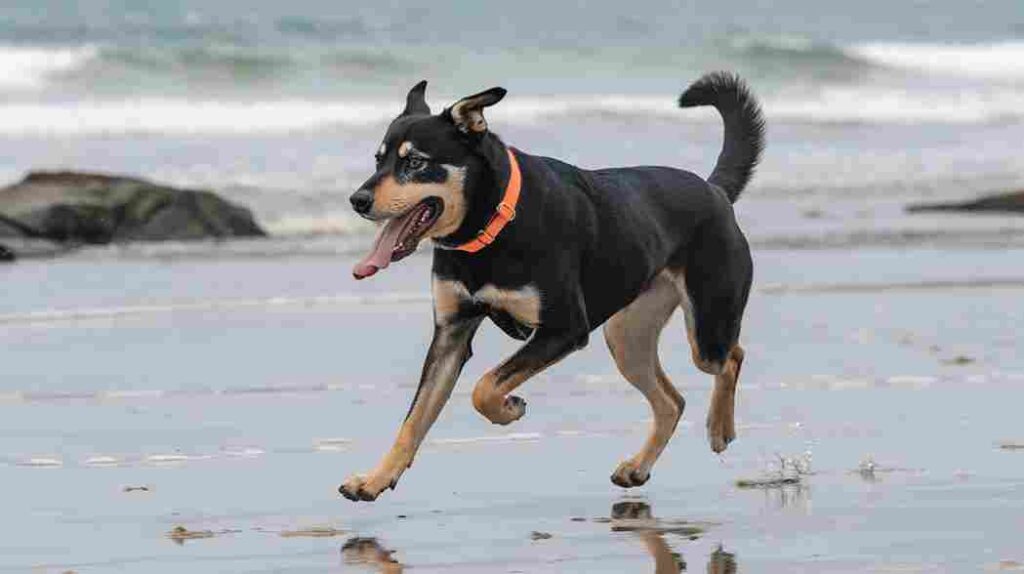
- Energetic and Playful: Rottskys are like little furry dynamos! As the American Kennel Club highlights, Rottweilers and Siberian Huskies are both high-energy breeds, meaning their offspring will likely inherit this trait. This means potential Rottsky owners should be prepared for a dog that needs a significant amount of daily exercise. They’re always up for an adventure, whether it’s a hike in the woods, a game of fetch, or just a good old-fashioned romp around the yard.
- Intelligent and Alert: These pups are quick learners, but they can also be stubborn (it’s that Husky independence!). Consistent training is key to keeping them on the right track.
- Wary of Strangers: Don’t be surprised if your Rottsky is a bit cautious around new people. It’s just their protective instincts kicking in. Early socialization will help them become more comfortable with strangers.
With their winning combination of loyalty, energy, and playful spirit, Rottskys make incredible companions for the right owner. Are you ready for the adventure?
Pros and Cons of Owning a Rottsky: Weighing the Scales
Let’s be honest, no dog is perfect (though Rottskys come pretty close!). Here’s a balanced look at the pros and cons of owning one of these amazing dogs:
Pros:
- Loyalty and protection: Rottskys are fiercely loyal and protective of their families.
- Intelligence and trainability: They’re quick learners and eager to please (most of the time!).
- Affectionate and playful: Rottskys love to cuddle and play with their loved ones.
- Versatility: They can excel in a variety of roles, from family companion to working dog.
Cons:
- High energy: Rottskys need a lot of exercise and mental stimulation.
- Training commitment: Consistent training is essential to manage their strength and intelligence.
- Potential health concerns: Be aware of potential health issues like hip dysplasia and eye problems.
- Size and space: They need a decent amount of space to thrive.
- Vocalization: Rottskys can be quite vocal, so be prepared for some barking and howling.
Care and Training: Raising a Well-Rounded Rottsky
-
Okay, you’ve fallen head over paws for the Rottsky – congrats! But before you bring one of these energetic pups home, you need to know how to care for them and unleash their full potential. Get ready for some serious playtime, training sessions, and maybe a little bit of mischief along the way!
Exercise: Unleash the Inner Athlete!
Rottskys are like furry bundles of energy on four legs. They’ve inherited the stamina of sled dogs and the drive of working dogs, so they need a LOT of exercise to stay happy and healthy (and to keep your furniture from becoming a chew toy).
- How much is enough? Aim for at least 90 minutes of vigorous exercise every single day. Yep, you read that right! These pups are serious athletes.
- Exercise ideas: Think beyond just walks around the block. Rottskys love activities like:
- Hiking: Explore the great outdoors together!
- Running: These dogs can be your perfect jogging partner.
- Agility training: Leaping over hurdles, weaving through poles – it’s like an obstacle course for dogs!
- Frisbee: These dogs have serious airtime!
- Dog sports: Canine athletes, unite! Rottskys can excel in sports like obedience, tracking, and even weight pulling (they’ve got those strong Rottweiler genes!).
- Swimming: Perfect for cooling off on a hot day and getting a full-body workout.
Training: Brains and Obedience
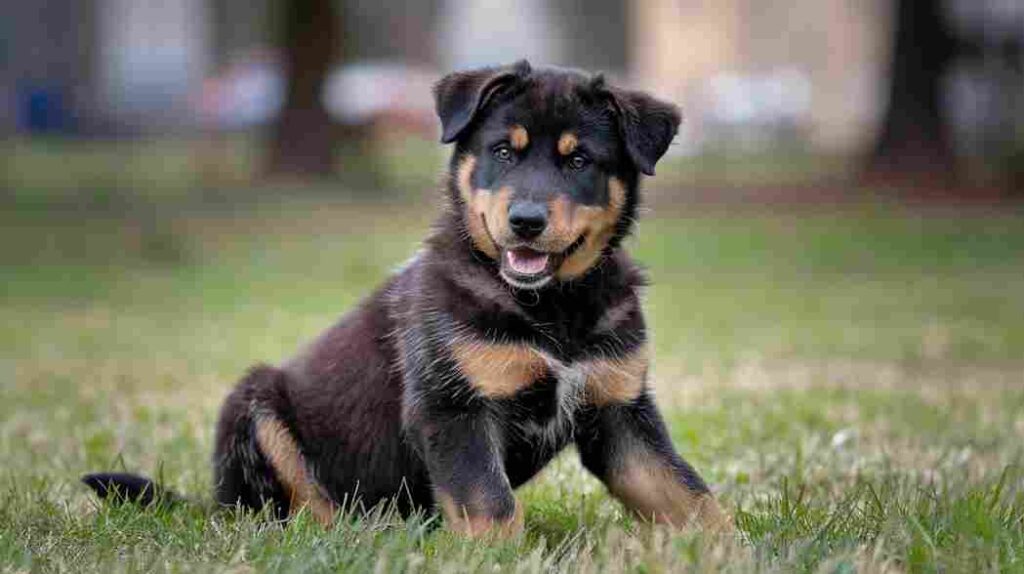
Rottskys can be stubborn, requiring patient and consistent training. -
Rottskys are intelligent, but they can also be stubborn (it’s that independent Husky streak!). Consistent, positive reinforcement training is the key to unlocking their full potential.
- Patience is a virtue: Don’t get discouraged if your Rottsky doesn’t pick things up right away. They’ll get there with patience and persistence.
- Positive vibes only: Ditch the punishment and embrace rewards! Think treats, praise, and playtime.
- Training tips:
- Crate training: A safe space for your pup to relax and learn some self-control.
- Basic commands: “Sit,” “stay,” “come” – these are the building blocks of good behavior.
- Leash manners: No one wants a dog that drags them down the street!
- Outsmart the stubbornness: Keep training sessions short and engaging to prevent boredom. Use high-value rewards to motivate your Rottsky.
Socialization: The World is Your Playground
Socialization is like doggy preschool – it teaches your Rottsky how to be a well-adjusted member of society. The more they’re exposed to different people, dogs, and environments, the more confident and well-behaved they’ll be.
- Socialization tips:
- Puppy classes: A great way for your pup to learn basic manners and meet new friends.
- Dog parks (with supervision): Let them run and play with other dogs in a safe environment.
- Everyday adventures: Take your Rottsky on walks in different neighborhoods, visit pet-friendly stores, and introduce them to new people (always with positive reinforcement!).
Nutrition: Fueling the Fun
All that playing and learning requires serious fuel! Rottskys need a high-quality diet that’s packed with protein and nutrients.
- Choose wisely: Look for dog food formulated for large, active breeds.
- Life stages: Puppies, adults, and seniors all have different nutritional needs. Make sure you’re feeding your Rottsky the right food for their age.
Mental Enrichment: Engage those Brains!
Rottskys are smart cookies, and they need mental stimulation to stay happy and entertained. A bored Rottsky can be a destructive Rottsky, so keep those brains engaged!
- Puzzle toys: Challenge your Rottsky with toys that make them think.
- Interactive games: Play hide-and-seek, tug-of-war, or even teach them some fun tricks.
- DIY enrichment: Create your own puzzle toys or set up obstacle courses in your backyard.
With a little TLC and a whole lot of adventure, your Rottsky will be the happiest and most well-behaved pup on the block!
Health Considerations: Keeping Your Rottsky Thriving
Even superheroes need a little TLC to stay in top shape, and your Rottsky is no exception! While they’re generally healthy pups, there are a few things to keep an eye on to ensure your furry friend lives a long and happy life.
Lifespan and Common Health Issues
- How long will my Rottsky be by my side? Rottskys typically have a lifespan of 8 to 14 years. That’s a good chunk of time to share adventures and cuddles!
- Health hurdles: Like their parent breeds, Rottskys can be prone to certain health issues, including:
- Hip and Elbow Dysplasia: Rottskys can be prone to hip dysplasia, a common condition in larger breeds (Orthopedic Foundation for Animals). This is a common problem in large breeds, where the joints don’t develop quite right. It can cause pain and mobility problems. Keeping your Rottsky at a healthy weight and providing regular exercise can help reduce the risk.
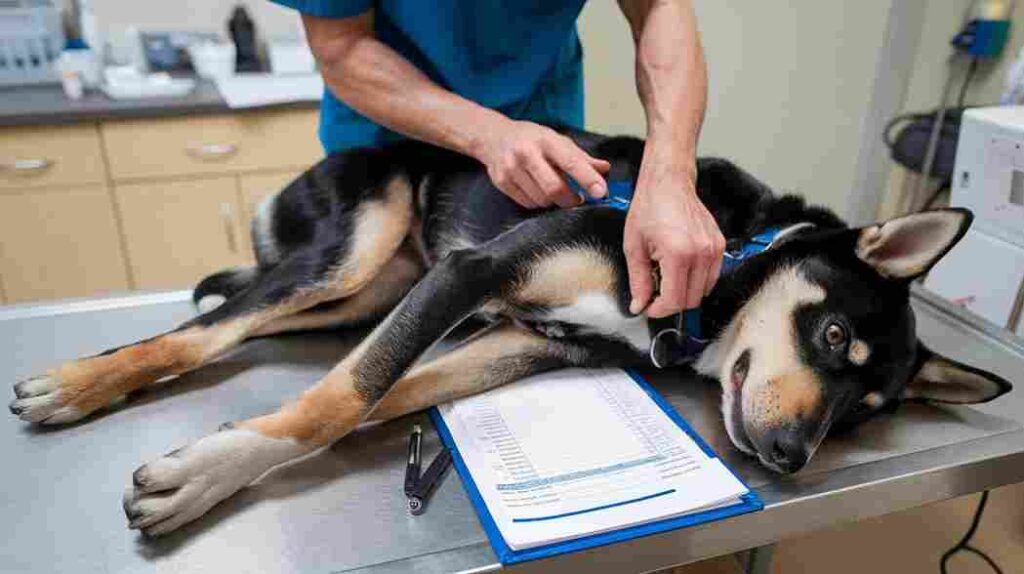
- Bloat: This is a scary condition where the stomach fills with gas and can even twist. It’s a medical emergency! Feed your Rottsky smaller, more frequent meals and avoid vigorous exercise after eating to help prevent bloat.
- Other potential problems: Keep an eye out for things like heart conditions, allergies, and certain types of cancer.
Eye Issues: Protecting those Peepers
Rottskys can inherit eye problems from both parent breeds, so it’s important to be aware of the potential issues and keep an eye on those precious peepers.
- Cataracts: These are cloudy areas in the lens of the eye that can affect vision. They’re more common in older dogs, but they can occur in younger Rottskys too.
- Progressive Retinal Atrophy (PRA): This is a degenerative disease that affects the retina and can lead to blindness. Unfortunately, there’s no cure for PRA, but early detection can help you manage the condition and provide your Rottsky with the best possible care.
Preventative Care: Superhero Health Plan
Prevention is the best medicine! Here’s how to keep your Rottsky feeling super:
- Vaccinations: Keep those puppy shots up to date! Vaccinations protect your Rottsky from nasty diseases.
- Parasite prevention: Fleas, ticks, and heartworm are no fun. Regular preventative meds will keep those pesky critters at bay.
- Dental care: Brush those pearly whites! Dental disease is common in dogs, so regular brushing and dental chews are a must.
- Vet checkups: Regular visits to the vet are like superhero checkups! They can catch any potential problems early on and keep your Rottsky in top shape.
Veterinary Care: Your Partner in Rottsky Health
Find a veterinarian you trust and who understands the unique needs of Rottskys. They’ll be your partner in keeping your furry friend healthy and happy for years to come. Remember, early detection is key to managing any health issues that may arise.
Living with a Rottweiler Husky Mix: Adventure Awaits!
So, you’re ready to welcome a Rottsky into your home? Get ready for a life filled with adventure, loyalty, and maybe a few surprises along the way. But before you roll out the welcome mat, let’s talk about what it really means to live with one of these amazing dogs.
Family Life: Rottskys and Kids
Rottskys can be fantastic family dogs, but there are a few things to keep in mind:
- Supervise with small children: These are big, strong dogs with lots of energy. While they’re generally gentle, accidental bumps and jumps can happen. Always supervise playtime between your Rottsky and young children.
- Training is key: Teach your kids how to interact with your Rottsky respectfully and make sure your dog understands boundaries.
- Socialization from day one: Expose your Rottsky to kids of all ages from a young age to help them become comfortable and confident around little humans.
Home Sweet Home: Space to Roam
Rottskys are active dogs that need space to stretch their legs (and their brains!).
- A yard is ideal: A fenced-in yard is a Rottsky’s dream come true! It gives them a safe space to run, play, and explore.
- Apartment living can work: If you live in an apartment, you’ll need to be extra dedicated to providing your Rottsky with plenty of exercise and mental stimulation. Frequent trips to the dog park or long walks are a must.
- Keep it comfy: Make sure your Rottsky has a cozy spot to relax indoors, whether it’s a dog bed, a comfy blanket, or (let’s be honest) a prime spot on the couch next to you.
Other Pets: Furry Friends
Rottskys can generally get along with other dogs, especially if they’re socialized from a young age. However, introductions should always be done slowly and carefully.
- Same-sex aggression: Keep an eye out for potential same-sex aggression, especially between males.
- Small pets: Rottskys have a strong prey drive (thanks to those Husky genes!), so smaller pets like cats or rabbits may need extra supervision.
Rottsky-Proofing Your Home: Safety First
Rottskys are energetic and curious, so it’s important to make your home a safe and secure environment for them.
- Secure your fences: Rottskys are known for their escape artist tendencies, so make sure your fences are high and secure.
- Provide appropriate chew toys: These pups love to chew, so provide them with plenty of durable chew toys to keep them entertained and prevent them from destroying your belongings.
- Manage potential hazards: Keep things like electrical cords, cleaning supplies, and medications out of reach.
- Create a safe space: Provide your Rottsky with a comfortable and secure den or crate where they can relax and feel safe.
Grooming Your Rottsky: Taming the Fluff
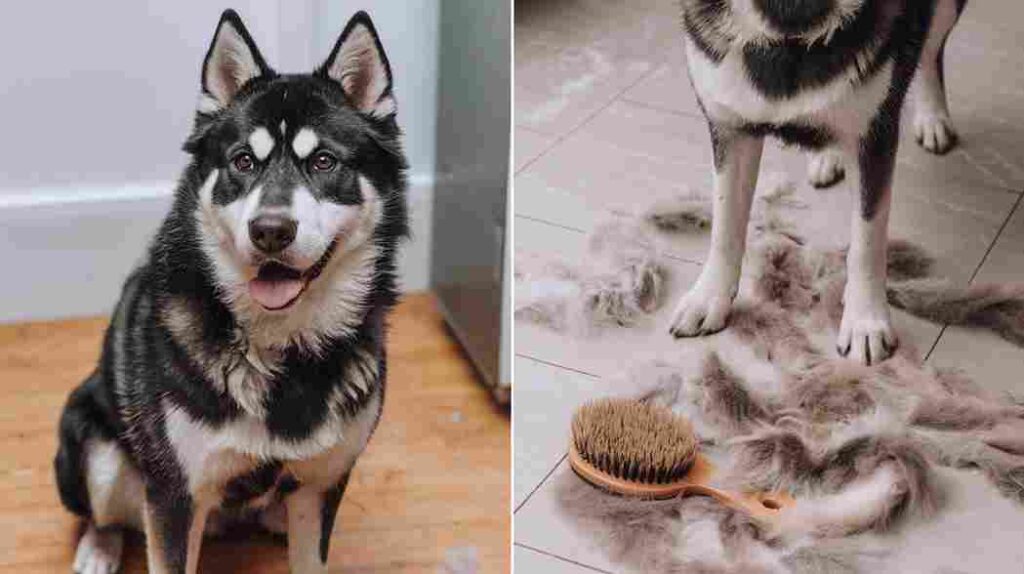
Get ready for fur flying! Rottskys are not exactly known for being low-shedders. But hey, who needs a pristine house when you have a furry best friend, right? Okay, maybe a little grooming can help with the fluff situation. Here’s the lowdown on keeping your Rottsky looking and feeling their best.
Coat Care: Double the Fluff, Double the Fun (and the Brushing!)
Rottskys inherit that luxurious double coat from both their Rottweiler and Husky parents. This means they’ve got a warm undercoat for those chilly days and a weather-resistant outer coat to keep them looking sharp. But it also means they shed…a lot.
- Brushing is your best friend: A good brushing session a few times a week will help remove dead fur, prevent mats, and keep your Rottsky’s coat healthy and shiny.
- Brush recommendations: Look for a slicker brush or a rake brush to tackle that thick double coat.
- Brushing frequency: Aim for at least 2-3 times a week, and more often during shedding season (get ready for fur tumbleweeds!).
Bathing: Splish Splash, Not Too Often!
Rottskys don’t need frequent baths, unless they’ve decided to roll in something particularly fragrant (we’re looking at you, mud puddles!).
- Bathing frequency: A bath every 6-8 weeks is usually enough to keep them clean and smelling fresh.
- Shampoo time: Use a dog-specific shampoo and conditioner to avoid irritating their skin.
Other Grooming Needs: Paws, Ears, and Teeth
- Nail trims: Keep those claws in check! Trim your Rottsky’s nails every couple of weeks to prevent overgrowth and discomfort.
- Ear cleaning: Check those floppy ears regularly for any signs of dirt or infection. Clean them gently with a dog-specific ear cleaner as needed.
- Dental care: Brush those pearly whites! Dental disease is common in dogs, so regular brushing and dental chews are a must.
Grooming Challenges: Shedding and Matting
- Shedding season survival guide: Rottskys are heavy shedders, especially during spring and fall. Be prepared to brush more often and invest in a good vacuum cleaner (you might even want to consider a robot vacuum – your new best friend!).
- Mat attack: Those thick double coats can be prone to matting, especially behind the ears and around the tail. Regular brushing and occasional trips to a professional groomer can help prevent mats.
With a little effort and a whole lot of love, you can keep your Rottsky’s coat looking its best!
Is a Rottsky the Right Breed for You?
So, you’ve reached the end of our Rottsky rollercoaster! Feeling the adrenaline yet? We’ve explored everything from those mesmerizing Husky eyes to those powerful Rottweiler instincts. Now it’s time for the ultimate question: Is this energetic mix your perfect match?
If you’re craving a loyal adventure buddy who’s always up for a challenge (and maybe a bit of mischief), then a Rottsky might just steal your heart. But remember, these pups need a lot of love, a whole lot of exercise, and a sprinkle of training magic to truly shine.
Ready to unleash the Rottsky within? Do your research, find a breeder or rescue that rocks your socks, and get ready for a lifetime of tail wags, endless games of fetch, and unforgettable adventures with your new Rottsky bestie!
FAQs: Your Rottsky Questions, Answered!
Q: Are Rottweiler Husky mixes good with kids?
A: Rottskys can be great with kids, but it's important to remember that they're large, powerful dogs with lots of energy. Always supervise interactions between your Rottsky and young children, and teach your kids how to interact with dogs respectfully. Early socialization with kids of all ages is key!
Q: How much exercise does a Rottweiler Husky mix need?
A: Buckle up, because these pups are energetic! Aim for at least 90 minutes of vigorous exercise daily. Think long walks, runs, hikes, frisbee, agility – anything to get those wiggles out!
Q: What are the common health problems of this mix?
A: Rottskys can be prone to certain health issues, including hip and elbow dysplasia, eye conditions (like cataracts and PRA), and bloat. Regular vet checkups and preventative care are crucial!
Q: Where can I find a reputable breeder?
A: Do your research! Look for breeders who prioritize health and temperament, do health testing on their dogs, and socialize their puppies. Ask lots of questions and don't be afraid to visit the breeder's facility.
Q: What should I feed my Rottsky?
A: Choose a high-quality dog food formulated for large, active breeds. Puppies, adults, and seniors all have different nutritional needs, so make sure you're feeding your Rottsky the right food for their age.
Q: Are Rottskys good apartment dogs?
A: Rottskys can adapt to apartment living, but it requires extra effort. They need plenty of exercise and mental stimulation, so frequent trips to the dog park or long walks are a must. If you live in an apartment, make sure you're prepared for the commitment!
Q: What kind of training do Rottskys need?
A: Rottskys are intelligent but can be headstrong. Start training early and be consistent! Positive reinforcement methods work best. Focus on basic obedience, leash manners, and socialization.
Q: How much do Rottskys shed?
A: Get ready for fur tumbleweeds! Rottskys are moderate to heavy shedders. Regular brushing will help control the fluff, but be prepared to vacuum often.
Q: What is the ideal home environment for a Rottweiler Husky mix?
A: Rottskys thrive in homes with active owners who can provide them with plenty of exercise and mental stimulation. A fenced-in yard is ideal, but apartment living can work with dedicated owners who prioritize outdoor time.
Q: Are Rottskys good with cats or other small pets?
A: Rottskys can get along with other pets, but early socialization is crucial. Supervise interactions with smaller pets due to their prey drive, and be mindful of potential same-sex aggression with other dogs.
Q: How can I prevent my Rottsky from escaping?
A: Rottskys are known escape artists! Secure your fences, supervise them closely during outdoor time, and ensure they have plenty of exercise and mental stimulation to prevent boredom-induced escapes.
Q: What are some common behavioral issues in Rottskys, and how can I address them?
A: Rottskys can be prone to stubbornness, destructiveness, and excessive barking. Address these issues with consistent training, plenty of exercise and mental enrichment, and early socialization.
“Thinking a Rottsky might be too much pup for you? Remember, they get half their wildness from those awesome Rottweilers! If you’re curious about this guardian breed’s history and unique personality, check out our in-depth guide: 101 Amazing Rottweiler Breed Facts: History, Temperament & Care. You might discover that a purebred Rottie is your perfect match!”


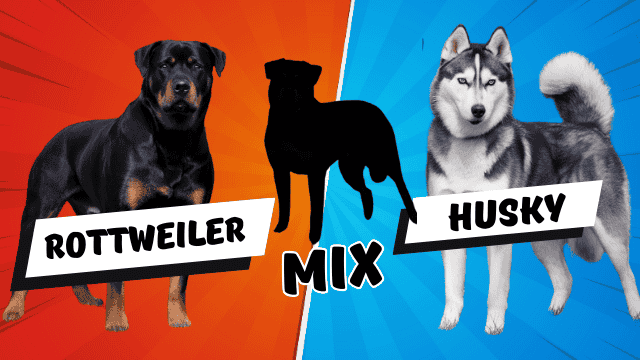


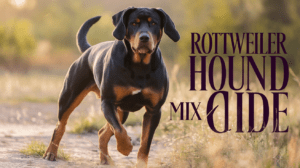
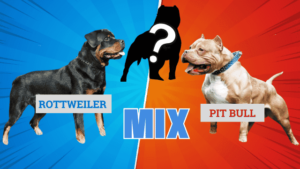
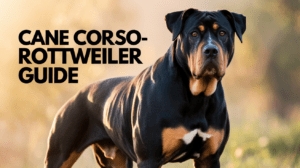
Pingback: 101 Amazing Rottweiler Breed Facts: History, Temperament & Care